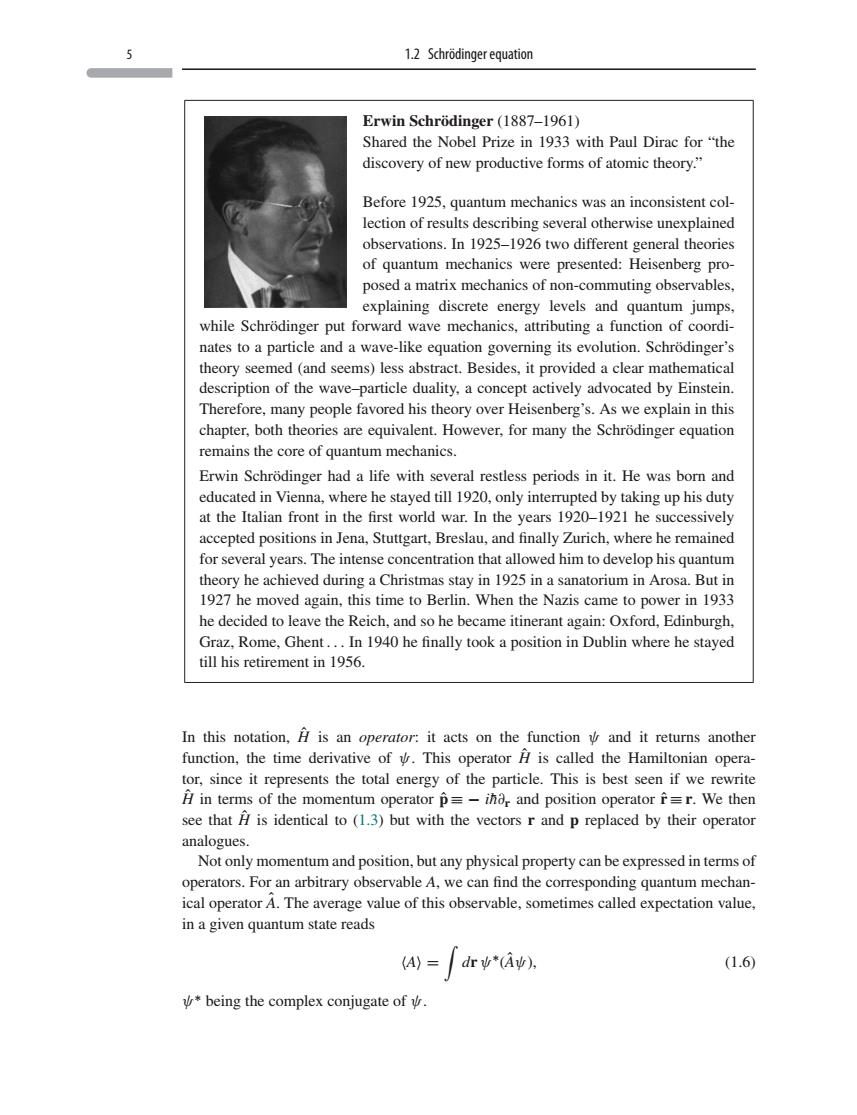正在加载图片...

Erwin Schrodinger(1887-1961) Shared the Nobel Prize in 1933 with Paul Dirac for "the discovery of new productive forms of atomic theory." Refore 1925 auantum mechanies was an inconsistent col. observations differe of quantum mechanics were presented:Heisenberg pro posed a matrix mechanics of non-commuting observables. explaining discrete energy levels and quantum iumps while Schrodinger put forward wave mechanics.attributing a function of coordi. nates toa particle and a wave-like equat n governing its theory seemed(and seems)less abstract.Besides,it provided a clear mathematica description of the wave-particle duality,a concept actively advocated by Einstein. Therefore,many people favored his theory over Heisenberg's.As we explain in this chapter,both theories are equivalent.However,for many the Schrodinger equation remains the core of quantum mechanics. Erwin Schrodinger had a life with several restless periods in it.He was born and educated in Vienna,where he stayed till 1920,only interrupted by taking up his duty at the Italian front in the first wo orld war in the ars1920-1921he uccessivel accepted positions in Jena Stuttgart,Breslau,and fin ally Zurich,where he remaine for several years.The intense concentration that allowed him to develop his quantum theory he achieved during a Christmas stay in 1925 in a sanatorium in Arosa.But in 1927 he moved again,this time to Berlin.When the Nazis came to power in 1933 he decided to leave the Reich.and so he became itinerant again:Oxford,Edinburgh Graz,Rome,Ghe In 1940 he finally took a position in Dublin where he staye till his retirement in 1956. In this notation,A is an operator:it acts on the functionand it retums anothe function,the time derivative of.This operator H is called the Hamiltonian opera- tor,since it represents the total energy of the particle.This is best seen if we rewrite A in terms of the momentum operatorp=-ihar and position operator =r.We then see that A is identical to(1.3)but with the vectors r and p replaced by their operator analogues. Not only momentum and position.but any physical property can be expressed in terms of operators.For an arbitrary observable A,we can find the corresponding quantum mechan- ical operator A.The average value of this observable,sometimes called expectation value. in a given quantum state reads 4=d*). (1.6) being the complex conjugate of. 5 1.2 Schrödinger equation Erwin Schrödinger (1887–1961) Shared the Nobel Prize in 1933 with Paul Dirac for “the discovery of new productive forms of atomic theory.” Before 1925, quantum mechanics was an inconsistent collection of results describing several otherwise unexplained observations. In 1925–1926 two different general theories of quantum mechanics were presented: Heisenberg proposed a matrix mechanics of non-commuting observables, explaining discrete energy levels and quantum jumps, while Schrödinger put forward wave mechanics, attributing a function of coordinates to a particle and a wave-like equation governing its evolution. Schrödinger’s theory seemed (and seems) less abstract. Besides, it provided a clear mathematical description of the wave–particle duality, a concept actively advocated by Einstein. Therefore, many people favored his theory over Heisenberg’s. As we explain in this chapter, both theories are equivalent. However, for many the Schrödinger equation remains the core of quantum mechanics. Erwin Schrödinger had a life with several restless periods in it. He was born and educated in Vienna, where he stayed till 1920, only interrupted by taking up his duty at the Italian front in the first world war. In the years 1920–1921 he successively accepted positions in Jena, Stuttgart, Breslau, and finally Zurich, where he remained for several years. The intense concentration that allowed him to develop his quantum theory he achieved during a Christmas stay in 1925 in a sanatorium in Arosa. But in 1927 he moved again, this time to Berlin. When the Nazis came to power in 1933 he decided to leave the Reich, and so he became itinerant again: Oxford, Edinburgh, Graz, Rome, Ghent ... In 1940 he finally took a position in Dublin where he stayed till his retirement in 1956. In this notation, Hˆ is an operator: it acts on the function ψ and it returns another function, the time derivative of ψ. This operator Hˆ is called the Hamiltonian operator, since it represents the total energy of the particle. This is best seen if we rewrite Hˆ in terms of the momentum operator pˆ ≡ − ih¯∂r and position operator rˆ ≡ r. We then see that Hˆ is identical to (1.3) but with the vectors r and p replaced by their operator analogues. Not only momentum and position, but any physical property can be expressed in terms of operators. For an arbitrary observable A, we can find the corresponding quantum mechanical operator Aˆ. The average value of this observable, sometimes called expectation value, in a given quantum state reads A = dr ψ∗(Aˆψ), (1.6) ψ∗ being the complex conjugate of ψ.�